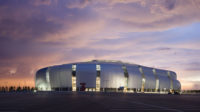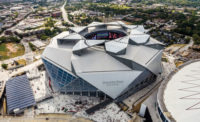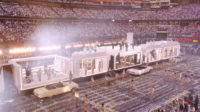This Sunday, some 75,000 people will fill the Mercedes-Benz Stadium in Atlanta to watch the New England Patriots face off against the Los Angeles Rams in Super Bowl LIII. For fans of architecture, the venue may just be as exciting as the big game itself.
Designed by HOK and completed in August 2017 (watch a time-lapse construction video below), the 2 million-square-foot facility is the world’s first LEED Platinum–certified professional sports stadium. Approximately 4,000 photo-voltaic panels supply power to the building and its surrounding parking lots, where electric vehicle connections are capable of charging almost 50 cars at one time. To mitigate flooding and conserve water, a 680,000-square-foot cistern can store 2 million gallons of rainwater. (The project sits at the top of the Proctor Creek watershed, just north of flood-prone downtown Atlanta.)
But the stadium’s most notable feature is its operable roof. Eight semi-transparent, single-ply ETFE panels move along straight lines, fully opening in 8 minutes and closing in 7. (Watch a time-lapse video below of the roof’s movement, which many have described as similar to a camera aperture.)
Architectural Record spoke with HOK’s Bill Johnson, the principal in charge and design principal for the project, about the stadium’s design, sports architecture as a specialty within the profession, and which team he’ll be rooting for on game day.
On the design vision for this project:
Johnson, who has spent his whole career in sports-specific architecture (previously with his own firm, 360 Architecture, and now with HOK’s Sports + Recreation + Entertainment practice), was involved with the Arizona Diamondbacks’ Chase Field in Phoenix in the late ‘90s. “Over the years the creativity plateaued, and we were seeing stadiums that were really similar in how they worked and were designed,” he recalls. “But when we interviewed for this project, we understood that Arthur Blank [the owner of the Atlanta Falcons] wanted an iconic architectural design, and that this was a time when we could break the mold and do something different.”
On challenging assumptions about sports-specific architecture:
“Architecture does not get a lot of airtime outside of our professional circles,” Johnson says, “so this week has been really interesting—the network and the media have really embraced the architecture of this venue, to the point that just normal people are talking about this building and this roof. That’s great for all of us, when any project can capture the imagination of people who don’t usually think much about architecture.”
“Frankly, sports architecture gets a bad rap in architectural circles, because there’s a lot of people who don’t consider it as an opportunity for innovation or artistic expression. So, I really hope this building changes the minds of people in our industry who have discounted the power of what sports architecture can mean for all of us.”
Will the roof be open for the Super Bowl?
“NFL rules require that the decision about whether to open the roof is made four hours before the start of a game, and that both teams have to be notified,” Johnson says, while also noting that the roof of the Mercedes-Benz Stadium is capable of being opened while spectators are inside. “There’s lots of speculation about what the NFL is going to do.” (Some have suggested that the roof may open for the halftime show.)
Who will Johnson be rooting for?
“I’m from Kansas City, Missouri,” says Johnson. “The Chiefs should have been there. So I’m going to take a pass and root for the Kansas City Chiefs next year, when they play in the HOK-designed Hard Rock Stadium in Miami.”
Time-lapse video courtesy of EarthCam
Video courtesy of Mercedes-Benz Stadium















Post a comment to this article
Report Abusive Comment